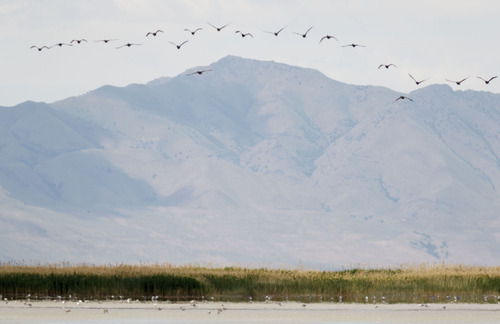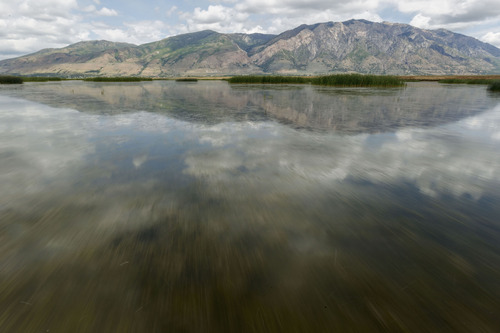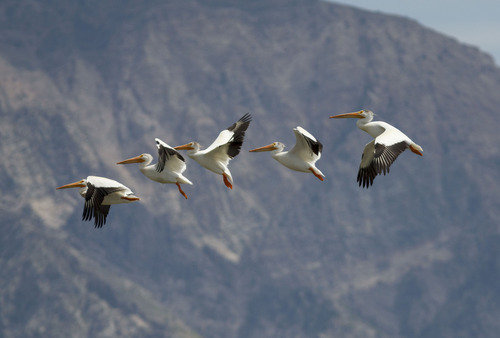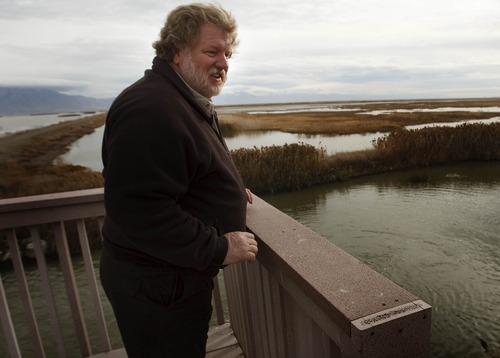This is an archived article that was published on sltrib.com in 2012, and information in the article may be outdated. It is provided only for personal research purposes and may not be reprinted.
The three national wildlife refuges managed by the U.S. Fish and Wildlife Service along the 500-mile-long Bear River are exactly that: shelters for wildlife from the ever-expanding human presence on the Western landscape.
Recognizing the refuges in Utah, Idaho and Wyoming are limited in size, Fish and Wildlife Service officials have come up with a plan to protect more crucial lands along the Bear River as it flows from the north slope of the Uinta Mountains of Utah into Wyoming and then Idaho before returning to Utah where it ends in the Bear River Migratory Bird Refuge west of Brigham City.
The plan does not involve creating new federal refuges but allows willing landowners along the Bear River to partner with the U.S. Fish and Wildlife Service in conservation easements.
"We feel this is a good way to deliver conservation on the ground without changing land ownership from private hands," said Amy Thornburg, Bear River Watershed Conservation Area project team leader and land protection planner for the U.S. Fish and Wildlife Service. "Easements are another tool in our tool box. They maintain a working landscape that wildlife depends on."
A series of five meetings — two in Utah — will be held in the three states over the next week to inform people about the program that allows the Fish and Wildlife Service to purchase easements from willing owners of land with important habitat for fish and wildlife in the Bear River watershed. Public comments will also be heard at the open houses.
Conservation easements are a voluntary legal agreement between the landowner and the Fish and Wildlife Service. The easements allow for traditional land practices like grazing and haying but prohibit subdivision. Public access remains controlled by the landowner, and taxes on the property remain local. The easements are signed for perpetuity and funded through the Land and Water Conservation Fund; prices are decided by fair market price.
"We are interested in getting input, ideas and concerns to help us design a project that is successful," said Bear River Migratory Bird Refuge manager Bob Barrett. "We have a sense of a great deal of support for the concept of conservation easements from the agricultural community. These easements allow the agricultural community to continue current operations but also protects the important lands of the Bear River watershed from development."
Other refuges along the Bear River include Cokeville Meadows National Wildlife Refuge in Wyoming and Bear Lake National Wildlife Refuge in Idaho. The watershed area is not limited to the Bear River corridor, it also includes tributaries and the lands around the waters. The area starts at the Bear River headwaters in the Uintas, flows through southwestern Wyoming and downtown Evanston, makes a quick jaunt back into Utah and then returns to Wyoming running north past Cokeville before turning west into Idaho.
In Idaho, the river passes near Montpelier, Soda Springs and Preston before making its final state border crossing into Utah's Cache County. It flows through the Cutler Marsh through Cutler Gap and into Box Elder County as it flows toward the Bear River Refuge and its eventual end at the Great Salt Lake.
Biologists say more than 200 species of birds can be spotted within the conservation area. Mammals within the Bear River watershed include elk, mule deer, moose, pronghorn, bear, coyote, fox and many more.
Three species were selected to help biologists track the health of the watershed and help them focus on the best locations for easements.
"We call them surrogate species," Barrett said. "They are umbrella species that are indicators of the quality of the habitat."
Two birds, the American avocet and sage thrasher, were selected as surrogate species, and so was the Bonneville cutthroat trout, Utah's state fish. It is unlikely that the species Utah has listed as sensitive resides on the last stretch of the Bear River between the Idaho border and the Bear River Refuge, but the fish remains in stretches of the river in Idaho, Wyoming and northeastern Utah.
Warren Colyer, watershed restoration programs director for Trout Unlimited, welcomes the easement program.
"This a great fit for work we have been doing along the entire Bear River drainage since 2005 as part of our native trout project. Conservation easements and land protection are crucial. We like to see ranches continue in perpetuity and see the agricultural community succeed," he said. "The alternative is we see subdivisions and development. Those things are pretty hard on fish and wildlife."
Colyer said that at last count Trout Unlimited, which does not do conservation easements, has worked on 35 fish passage restoration projects, improved or restored connections in about 150 miles of streams in the watershed and spent more than $5 million helping landowners create more efficient and fish-safe means of delivering water across their lands.
The five public meetings — the two in Utah are Tuesday in Logan and Wednesday in Randolph — will gather comments and input that will be given consideration before the U.S. Fish and Wildlife Service takes the step of actively seeking landowners willing to sign conservation easements. There are already a number of volunteers.
For more information on the program, go to 1.usa.gov/TwCd5C.
Meetings set on Bear River watershed plan
P The U.S. Fish and Wildlife Service is hosting a series of public meetings to provide information about and hear public comment on a draft land protection plan and environmental assessment for the Bear River Watershed Conservation Area. The project would create a conservation easement program for willing landowners in the watershed area of northern Utah, southwestern Wyoming and southeastern Idaho. Visit the Fish and Wildlife Service website for more details. All meetings will run from 5:30 to 7:30 p.m.
Tuesday • Cache County Fairgrounds Pavilion, 450 S. 500 West, Logan
Wednesday • Rich County Senior Citizens Center, 21 N. Main St., Randolph
Thursday • Bear Lake County Senior Citizens Center, 300 Hospital Way, Montpelier, Idaho
Friday • Franklin Fire Protection District, 55 W. 1st St., Preston, Idaho
Dec. 11 • Uinta County Library, 701 Main St., Evanston, Wyo.























